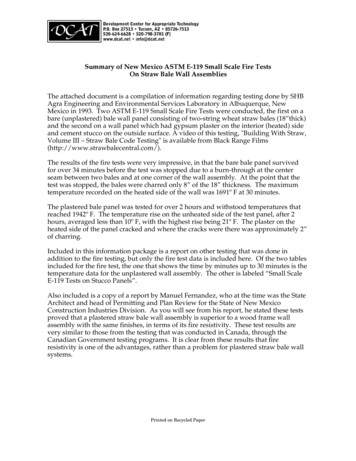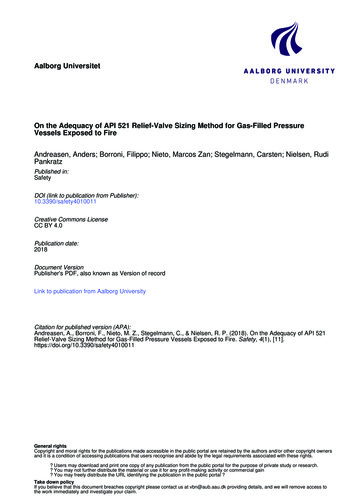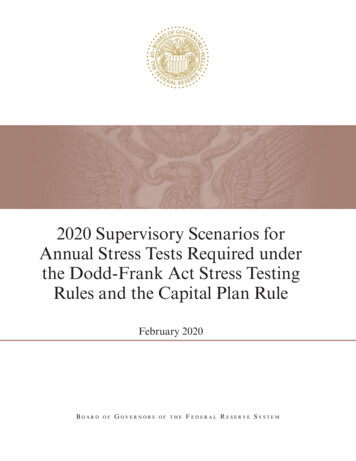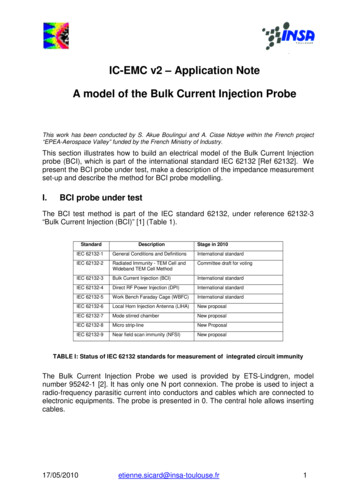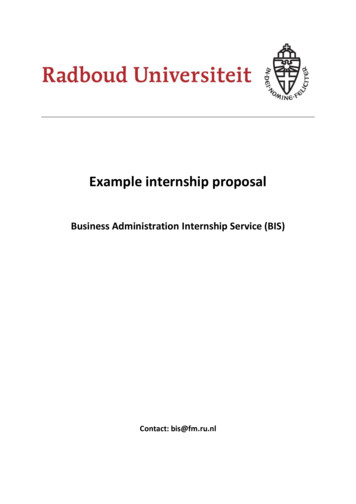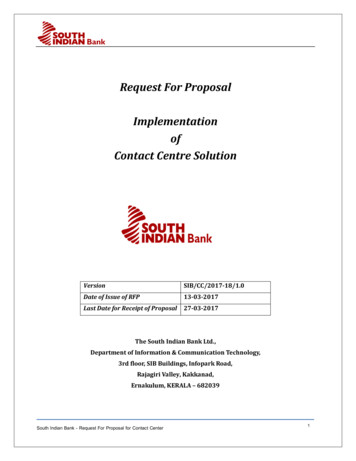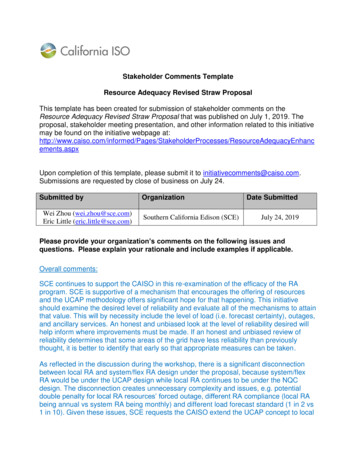
Transcription
Stakeholder Comments TemplateResource Adequacy Revised Straw ProposalThis template has been created for submission of stakeholder comments on theResource Adequacy Revised Straw Proposal that was published on July 1, 2019. Theproposal, stakeholder meeting presentation, and other information related to this initiativemay be found on the initiative webpage Processes/ResourceAdequacyEnhancements.aspxUpon completion of this template, please submit it to initiativecomments@caiso.com.Submissions are requested by close of business on July 24.Submitted byWei Zhou (wei.zhou@sce.com)Eric Little (eric.little@sce.com)OrganizationSouthern California Edison (SCE)Date SubmittedJuly 24, 2019Please provide your organization’s comments on the following issues andquestions. Please explain your rationale and include examples if applicable.Overall comments:SCE continues to support the CAISO in this re-examination of the efficacy of the RAprogram. SCE is supportive of a mechanism that encourages the offering of resourcesand the UCAP methodology offers significant hope for that happening. This initiativeshould examine the desired level of reliability and evaluate all of the mechanisms to attainthat value. This will by necessity include the level of load (i.e. forecast certainty), outages,and ancillary services. An honest and unbiased look at the level of reliability desired willhelp inform where improvements must be made. If an honest and unbiased review ofreliability determines that some areas of the grid have less reliability than previouslythought, it is better to identify that early so that appropriate measures can be taken.As reflected in the discussion during the workshop, there is a significant disconnectionbetween local RA and system/flex RA design under the proposal, because system/flexRA would be under the UCAP design while local RA continues to be under the NQCdesign. The disconnection creates unnecessary complexity and issues, e.g. potentialdouble penalty for local RA resources’ forced outage, different RA compliance (local RAbeing annual vs system RA being monthly) and different load forecast standard (1 in 2 vs1 in 10). Given these issues, SCE requests the CAISO extend the UCAP concept to local
RA and consider aligning study assumptions in setting local requirements1 with those forsystem RA.In the area of the UCAP design as a separate framework from the CPUC NQC construct,SCE continues to believe the outcome of having two frameworks is not acceptable. Theresult of having two distinct frameworks is that LSEs now would have to meet therequirements from both RA frameworks, which can bring significant inefficiencies to theRA program and additional costs to LSEs. The resource set that meets the CPUC NQCrequirement may turn out to be insufficient to meet the CAISO UCAP requirement, or viceversa. In the first case, LSEs would have to either procure resources additional to thoseshown to CPUC or bear the costs of the CAISO backstop procurement. In the secondcase, CPUC-jurisdictional LSEs would bear the non-compliance risk and associatedpenalties from CPUC. This inefficiency does not exist today but would be introducedunder the CAISO proposal. The CAISO should fully coordinate with CPUC to ensure asingle framework for the RA program. Potentially, the CAISO should coordinate with otherLRAs and the CEC to make it a state-wide uniform program for all LSEs.While SCE understands the objective of a portfolio deficiency test, the efficacy of such aprocess on the overall RA program needs further evaluation. In order for the RA programto function as a whole, the LSEs will need to have sufficient information prior to solicitingfor RA to ensure that their procurement will adequately address RA needs and mitigatethe potential for backstop procurement. This issue is also present for local RA and in thediscussions of Multi-year local RA requirements, many comments have been providedasking that the CAISO make available to LSEs the need for specific resources as well aseffectiveness factors of the local resources. With that information in hand, LSEs canundertake bilateral contracting with reasonable assurance that their procurement willresult in a portfolio that effectively addresses the reliability need. For system and flex RAin a UCAP environment, the same consideration will need to be made. LSEs need to beprovided with as much information as practical to help guide their procurement decisionssuch that they can minimize the need for CAISO backstop procurement. This isparticularly important since the CAISO has proposed the timing of the test to occur aftermonthly showing and there is a tight time window for LSEs to cure2 for the portfoliodeficiency. It is unclear how the cure process would function, (e.g. when each LSE meetsits own UCAP requirement but there is a collective portfolio deficiency). The CAISOshould provide further details on the cure process. The proposed cost allocation, basedon load ratio, should be further examined under the cost causation principle, since thedeficiency amount may arise from issues (e.g. ramping and duration requirements) otherthan meeting peak load.1Accordingly, the load forecast for local RA would change from 1 in 10 to 1 in 2. In the alternative, a review of theappropriate level of load forecasting certainty (e.g. 1-in-2, 1-in-5, 1-in-10) could be evaluated consistently among thethree RA requirements (system, local, and flex). Through this initiative, SCE seeks to have clear and well documentedobjectives of the various reliability requirements. What issues the requirement is trying to solve and the quantity ofRA that is being required to solve each of those requirements will help to evaluate necessary changes in the future.2Revised Straw Proposal, p. 22, “[i]f the portfolio is unable to serve load under given load or net load conditions, thenCAISO will declare a collective deficiency, provide a cure period, and will conduct backstop procurement”. Availableat l-ResourceAdequacyEnhancements.pdf
SCE notes that the CAISO has expressed concern that meeting a peak load or peak netload need under an environment of increased reliance on resources with some form ofuse limitation is not sufficient to meet reliability needs. As discussed above, SCE believesthat now is the time to evaluate the efficacy of the RA program overall. This shouldinclude evaluation of existing mechanisms designed to ensure that not only are peak loadneeds met, but there is sufficient capacity to meet the load needs in non-peak hours aswell. Given these issues, the CAISO should evaluate the existing Maximum CumulativeCapacity mechanism if the underlying need is to address hourly requirements associatedwith use limitation of resources.Regarding the proposal of 3-hour, 1-hour and 15-minute flex RA products, SCEappreciates the information the CAISO provided in the FRACMOO initiative.3 While theinformation is helpful, without more complete understanding of what the data represents,it is not possible to reach a conclusion at this time. SCE therefore asks that the CAISOwork with any interested party to share the data (without revealing any confidential and/ormarket sensitive data) as well as the methodology so that parties can assess theaccuracy of this analysis and its application to the RA structure.1. System Resource Adequacy Please provide your organization’s feedback on the Determining System RARequirements as described in Section 5.1.1.SCE believes that FRP and Regulation requirements should not be included insetting system RA requirements as these requirements should already be coveredunder a peak load requirement. The CAISO should document how the proposedrequirement compares to existing NQC requirement and show the comparison bycomponent (including percentage for forced outage, reserve products and loadforecast variation when applicable). Please provide your organization’s feedback on the Forced Outage Rates andRA Capacity Counting as described in Section 5.1.2.The CAISO should consider the shift in net peak load to later hours in the day insetting the outage assessment window. One option is to shift the proposed 16-hourassessment window by one hour, i.e. from 5AM-9PM to 6AM-10PM. Please provide your organization’s feedback on the System RA Showings andSufficiency Testing as described in Section 5.1.3.Please see SCE comments at the beginning of this ceAdequacyCriteria-MustOfferObligationPhase2.pdf at page 45
Please provide your organization’s feedback on the Must Offer Obligation andBid Insertion Modifications as described in Section 5.1.4.SCE agrees with the CAISO that “it may not be appropriate to apply bid insertion toresources with variable output ” For example, what would be the inserted bidquantity the CAISO intends to use for variable output RDRR demand responseresources, such as weather sensitive DR programs.4 While the CAISO’s revisedstraw proposal acknowledges that bid insertion may not be appropriate for variableoutput resources, its listed exemptions (see revised straw proposal pages 29-31,Table 5) do not include RDRR as being exempt from bid insertion. SCE proposesthe RDRR product continue being exempted from bid insertion, similar to PDR,Eligible Intermittent Resource, and NGR. Please provide your organization’s feedback on the Planned Outage ProcessEnhancements as described in Section 5.1.5.As discussed during the workshop, the CAISO proposal related to planned outagesubstitution should make it clear that, no “false information” would be deemed incases when a planned outage without substitution is approved by the CAISO, butis subsequently cancelled by the CAISO and becomes a forced outage. Thisclarification is needed to make the process of planned outage substitutionobligation (POSO) more transparent.There are instances where an approved planned outage is turned into a forcedoutage when the duration of the planned outage exceeds the initial planned timewindow. When this occurs, the resource loses the opportunity to providesubstitution capacity for the extended time window and subsequently encounterRAAIM penalty under existing rules today. As the CAISO proposal would eliminateRAAIM penalty for forced outages, it would then follow that once a planned outageextends beyond the initial approved time window and becomes a forced outage, itwould be subject to the UCAP counting for the duration of the extended timewindow (that does not include initial approved time window). The CAISO shouldclarify this understanding in its proposal. Please provide your organization’s feedback on the RA Import Provisions asdescribed as described in Section 5.1.6.SCE appreciates the CAISO updated analysis on RA import. In particular, theupdated analysis has concluded that the potential reliability impact of RA importnon-delivery may be less a concern than previously thought.SCE supports the inclusion of appropriate provisions (e.g. applicable firm energyrequirements for RA imports) in the CAISO tariff so the rules apply to all LSEs.SCE’s DR programs such as the Summer Discount Plan (SDP) have variable available MW by hour, driven bytemperature variation and the associated air conditioning loads.4
SCE continues to oppose any proposal of resource specification requirement forRA import. Given that the CAISO’s proposal of requiring source BAA is intendedfor preventing double counting, SCE requests the CAISO provide further details onthe issue of double counting so stakeholders can assess whether the proposal isnecessary or appropriate to address the issue. Please provide your organization’s feedback on the Maximum Import CapabilityProvisions as described in Section 5.1.7.The CAISO should evaluate whether the proposed auction mechanism would solvethe issue it intends to address. SCE believes that the most concerning issuediscussed at the stakeholder meeting was the lack of availability of ImportAllocation Rights (IAR) after the allocation process for liquid trading purposes. Ifthis is the issue, then the stakeholder process should focus on defining thisproblem. Included in that definition, SCE asks that the CAISO provide moreinformation on how much of IAR capacity was historically unused. This informationshould be provided by each import point to determine if the unused amounts are atliquidly traded energy locations or at other points for which it may be less likely toobtain an import to utilize for RA.Even if the issue, as described above, is found to be problematic, it is not clear thatan auction mechanism would mitigate this issue. That is, an LSE that purchasedIARs may still be unwilling to trade those rights once procured in an auction.Rather, the LSE may choose to hold those rights examining the potential toprocure an import for which they would then need the IAR. In such a case, theability to transact for IARs to meet RA needs may be illiquid. In this case, SCEbelieves that the other portion of the CAISO proposal to utilize a bulletin board toinform the market of need and availability of IARs would be more beneficial towardmeeting the market’s needs.In summary, please provide your organization’s position on System ResourceAdequacy (Section 5.1). (Please indicate Support, Support with caveats, Oppose, orOppose with caveats)As reflected in the comments above, SCE supports with caveats, i.e. SCE supportsthe main UCAP proposal conditioned on 1) there is a single RA framework, and 2) thedisconnection between system RA and local RA is addressed.2. Flexible Resource Adequacy Please provide your organization’s feedback on the Identifying FlexibleCapacity Needs and Requirements as described in Section 5.2.1.Please see SCE Overall Comments at the beginning of this document.
Please provide your organization’s feedback on the Identifying Flexible RARequirements
Stakeholder Comments Template Resource Adequacy Revised Straw Proposal This template has been created for submission of stakeholder comments on the Resource Adequacy Revised Straw Proposal that was published on July 1, 2019. The proposal, stakeholder meeting presentation, and other information related to this initiative
